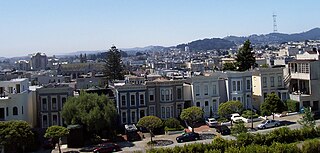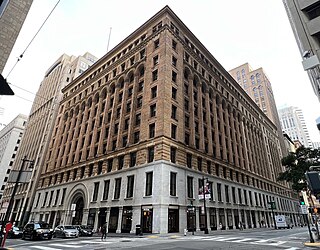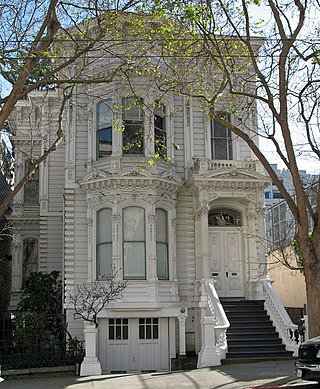
A National Historic Landmark (NHL) is a building, district, object, site, or structure that is officially recognized by the United States government for its outstanding historical significance. Only some 2,500, or roughly three percent, of over 90,000 places listed on the country's National Register of Historic Places are recognized as National Historic Landmarks.

Founders' Rock is a historical site located on the corner of Hearst Avenue and Gayley Road, in Berkeley, California, U.S.. The spot, according to college lore, where the 12 trustees of the College of California, the nascent University of California, Berkeley, stood on April 16, 1860, to dedicate the property they had just purchased. This is, supposedly, the same spot where Frederick H. Billings stood in 1866 when he remembered Bishop Berkeley's verse — "Westward the course of empire takes its way" — and thus inspired the name of the new city.

Bernard Ralph Maybeck was an American architect in the Arts and Crafts Movement of the early 20th century. He worked primarily in the San Francisco Bay Area, designing public buildings, including the Palace of Fine Arts in San Francisco, and also private houses, especially in Berkeley, where he lived and taught at the University of California. A number of his works are listed on the National Register of Historic Places.

The Cloyne Court Hotel, often referred to simply as Cloyne, is a historical landmark in Berkeley, California and currently one of the houses of the Berkeley Student Cooperative (BSC), a student housing cooperative. It is located at the north side of the University of California, Berkeley campus at 2600 Ridge Road, near Soda Hall and Jacobs Hall, and is the next door neighbor of the Goldman School of Public Policy.

The Western Addition is a district in San Francisco, California, United States.

Berkeley Community Theater is a theater located in Berkeley, California, United States, on the campus of Berkeley High School. The theater is administered by the Berkeley Unified School District. It is listed as a Berkeley Landmark since December 7, 1992. It is part of the Berkeley High School Campus Historic District, and the Berkeley Historic Civic Center District.

List of the National Register of Historic Places listings in Franklin County, New York

In the law regulating historic districts in the United States, a contributing property or contributing resource is any building, object, or structure which adds to the historical integrity or architectural qualities that make the historic district significant. Government agencies, at the state, national, and local level in the United States, have differing definitions of what constitutes a contributing property but there are common characteristics. Local laws often regulate the changes that can be made to contributing structures within designated historic districts. The first local ordinances dealing with the alteration of buildings within historic districts was enacted in Charleston, South Carolina in 1931.

Whitley Court is a cluster of Spanish Colonial bungalows built from 1903 to 1919 just north of Hollywood Boulevard in Hollywood, Los Angeles, California.

The Hillside Club is a neighborhood social club established in 1898 by residents of Berkeley, California's newly formed Northside neighborhood to protect the hills from unsightly grading and unsuitable buildings. It took its cue from the Arts and Crafts movement. The building is listed on the National Register of Historic Places since April 16, 2004, under the name "Berkeley Hillside Club"; and listed as a Berkeley Landmark by the city since January 12, 2004.

This is a list of the National Register of Historic Places listings in Alameda County, California.

The Mills Building and Tower is a two-building complex following the Chicago school with Romanesque design elements in the Financial District of San Francisco, California. The structures were declared San Francisco Designated Landmark #76, and were listed on the National Register of Historic Places in 1974.

The Stadtmuller House, or F. D. Stadtmuller House, is a historic house built in 1880, and located in the Western Addition neighborhood of San Francisco, California. It is notable for its architecture.

The Bush Street–Cottage Row Historic District is a historic district located in the Japantown area of San Francisco, California, U.S.. The area is a residential enclave comprising 20 historical residences, a walkway, and a small park. It is listed as a San Francisco Designated Landmark since September 1991, under the name " Bush Street–Cottage Row"; listed as a listed California Historical Landmark since December 27, 1982; and listed on the National Register of Historic Places on December 27, 1982, for architecture.

Golden Sheaf Bakery is a historical building and former bakery built in 1905 and located at 2069–2071 Addison Street in Berkeley, California, U.S. It is listed on the National Register of Historic Places since March 31, 1978; listed as a California Historical Landmark since March 31, 1978; and listed as a Berkeley Landmark since October 17, 1977.

The Berkeley Historic Civic Center District is a 9.9-acre (4.0 ha) historic district in Berkeley, California, U.S. It comprises portions of a five-block area surrounding Martin Luther King Jr. Civic Center Park, primarily made up of civic-related buildings. It has been listed as one of the National Register of Historic Places since December 3, 1998; and listed as a Berkeley Landmark by the City of Berkeley since December 7, 1998.

Loring House is a historical commercial building, built in 1914 in Berkeley, California, U.S.. The building and it site was listed on the National Register of Historic Places on July 13, 1989; and is a Berkeley Landmark since October 16, 1989. It is also called the William Lovering Locke House, and the Ernest L. Loring House.

















